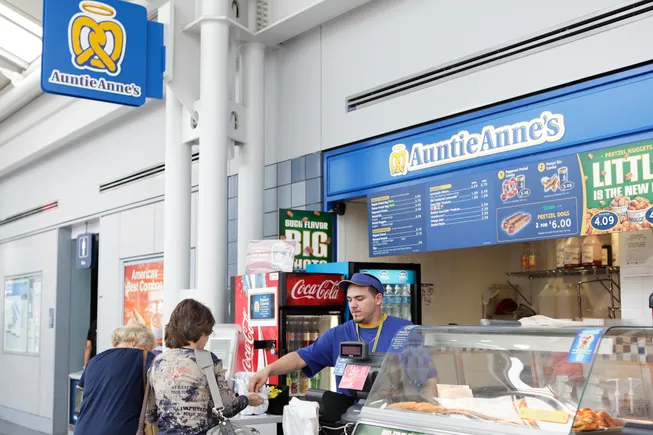Auntie Anne’s is synonymous with mall snacking, and the bulk of its storebase is in shopping mall units. But as malls face development challenges — like much of brick-and-mortar retail — Auntie Anne’s is turning to high-volume airport locations to support its development, said Bobby Morena, chief development officer at GoTo Foods.
“They’re not building that many more new malls,” Morena said. Auntie Anne’s, according to its franchise disclosure document, had about 526 franchised mall locations and 105 outlet center locations at the end of 2024. The chain has 50 airport locations as of July 2025, which means the chain has significant room to grow its airport presence.
Compared to Auntie Anne’s other captive audience locations, airports offer some significant advantages, Morena said.
“You do business in a ballpark when there’s a ball game or when there’s a concert, but there’s not always an event, and so you’ve got some days where you’re not open for business. So we love the 365-day, year-round business that airports have to offer,” Morena said.
And then there’s the volume of consumers passing through airports: 87.8 million passengers moved through the Dallas Fort Worth International Airport last year, according to the airport’s own statistics. Auntie Anne’s currently has five locations at that airport, operated by franchisee Randy Labosco, who is in the process of opening two more. Once Labosco finishes building out the remaining two locations, the chain will have one in every terminal.
The natural foot traffic in airports has made them significant sales drivers for Auntie Anne’s: The average sales volume at an airport location is roughly $1.8 million, according to the chain’s franchise disclosure document, more than twice the volume of its mall locations.
Morena said this means the primary operational challenge in airports is keeping pace with demand, but that Auntie Anne’s concept is designed for fairly streamlined operations.
“We pride ourselves that it’s a relatively simple operation — the way that we prep the product to have product on hand to serve a large amount of people in a not-so-large amount of time. We’re trying to capture as much of that traffic as we possibly can,” Morena said. “If you see a line of people at Auntie Aunne’s, you know we are absolutely swamped because our throughput is high.”
One part of the chain’s strategy in airports is to use the smell of its products as a form of marketing — the buttery, baked smell of pretzels permeates nearby gates, drawing consumers.
“The model is literally perfectly suited for these high-volume, high-velocity locations,” Morena said. “It’s just as much about impulse as it is about anything else, and that smell emanates from the store.”
In a carefully selected, high-traffic spot, that aroma can prove a powerful asset, but it takes both the right location and the right operator to make an airport location work.
Permitting can take a while for airport locations, Morena said, so it’s important to choose franchisees that have — or can build — strong ties with the airport itself. Those relationships help open up opportunities for development, and once development does start, construction is typically faster than it is at traditional restaurant locations, Morena said.
“We assist our franchisees in any way or shape we can, from a design and construction standpoint, to help get them open faster,” Morena said.
While the airport locations are a destination in themselves, the high volume of passenger traffic serves a secondary purpose: Getting consumers used to seeing Auntie Anne’s, so that the brand meets with greater success.
Streetside suburban development
Regardless of whether a consumer stops at an Auntie Anne’s in an airport, the brand’s presence and aroma increases awareness. This dynamic serves as marketing for locations outside of captive audience venues, Morena said.
The bulk of Auntie Anne’s growth over the next decade will be in streetside locations — traditional restaurants — rather than captive audience locations, though these will still play a role.

Auntie Anne’s is working on refreshing its store identity.
Courtesy of GoTo Foods
“We are standing on the shoulders of the success that that brand has had in captive venues, and it has gained a serious following from those venues,” Morena said. When Auntie Anne’s does go into new markets, it will look to that brand loyalty as a way to bring in new customers.
Another way to draw in new consumers, Morena said, is the chain’s recent modernization of its store image.
“We’re going to be remodeling over 150 locations this year with that look,” Morena said. “That’s going to grab attention from our current customers as well as other folks that may not have been to Auntie Anne’s before.”
But co-branding will play a role, particularly with Cinnabon, another GoTo Foods brand. Snacking, Morena said, is becoming a more significant daypart, and co-branding the two concepts in suburban markets gives GoTo a menu that crosses several dayparts and different kinds of consumer desires.
“When we go into streetside suburban areas or streetside urban areas you’ll see those two together under the same roof,” Morena said. “That allows us access to spaces in traditional real estate that we might not otherwise be able to afford if it was just one brand or the other.”
